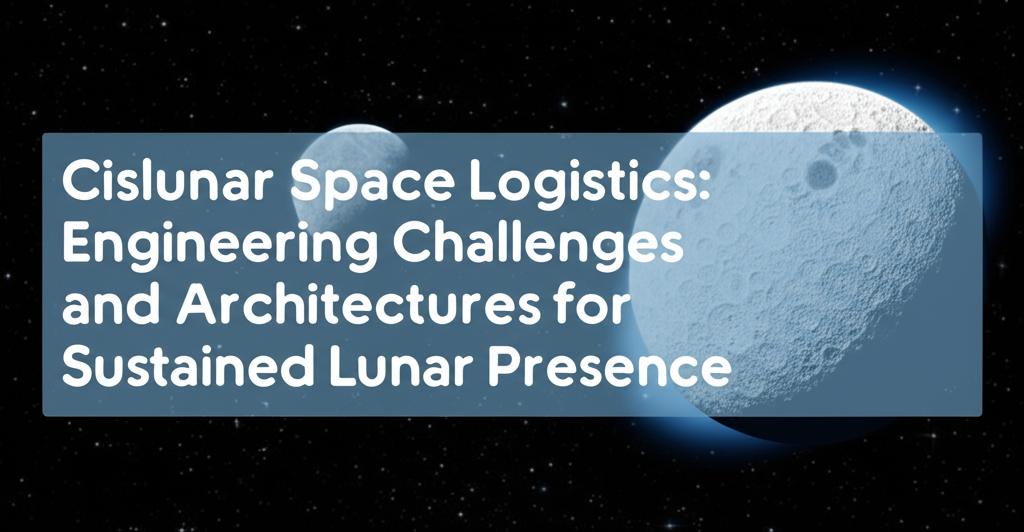Establishing a long-term human presence on the Moon requires moving beyond short-duration sortie missions towards sustainable operations. Central to this goal is the development of robust cislunar logistics – the systems and processes needed to transport, support, and maintain assets and personnel between Earth, lunar orbit, and the lunar surface. This involves creating complex architectures and overcoming significant engineering hurdles unlike those faced in Low Earth Orbit (LEO).
The Need for Advanced Cislunar LogisticsSustained lunar presence, as envisioned by programs like Artemis, necessitates a fundamental shift in how space operations are conducted. Unlike LEO, which is hours away, the Moon is days away, demanding greater self-sufficiency and پیشرفته planning. Key drivers for robust cislunar logistics include:
- Regular Crew and Cargo Transport: Moving people, supplies, scientific equipment, and infrastructure elements reliably and affordably.
- In-Space Infrastructure: Establishing platforms like the Lunar Gateway or depots at Lagrange points to serve as aggregation points, refueling stations, habitats, and staging areas for lunar surface and deep space missions.
- Resource Management: Handling the delivery, storage, and transfer of vital resources like propellant, water, oxygen, and power.
- Supporting Surface Operations: Enabling longer stays on the Moon with habitats, rovers, and power systems, all requiring regular resupply and maintenance support delivered through the cislunar network.
Several key components form the basis of proposed cislunar logistics architectures:
- Transportation Systems: Reusable spacecraft are crucial for cost-effectiveness. This includes Earth-to-orbit launchers, in-space transfer vehicles (potentially using high-efficiency Solar Electric Propulsion - SEP - for cargo, balanced with faster chemical propulsion for crew), lunar landers (both crewed and cargo), and ascent vehicles. Developing systems capable of handling propellant transfer in space is also vital.
- The Lunar Gateway: Planned as a cornerstone of the Artemis program, the Gateway is a small space station intended for a Near-Rectilinear Halo Orbit (NRHO) around the Moon. It serves multiple roles: a logistics hub for resupply missions, a temporary habitat for astronauts, a science platform, a communication relay, a command center for surface operations, and a staging point for missions to the lunar surface and eventually Mars. Its modular design allows for expansion and upgrades over time, incorporating international and commercial partner contributions.
- In-Situ Resource Utilization (ISRU): Harvesting and utilizing resources found on the Moon, particularly water ice potentially located in permanently shadowed regions near the poles, is seen as a game-changer. Extracting water and processing it into hydrogen and oxygen could provide propellant, breathable air, and water locally, significantly reducing the enormous cost and mass needed to launch these resources from Earth. Architectures are being studied to optimize ISRU plant location, deployment, and logistics, comparing centralized facilities with distributed networks.
- Logistics Bases/Depots: Beyond the Gateway, concepts include placing logistics facilities or propellant depots at stable locations like Earth-Moon Lagrange points (L1 or L2) to facilitate efficient transfer and storage of resources.
- Communication and Navigation Networks: A dedicated network providing continuous communication, positioning, navigation, and timing (PNT) services throughout cislunar space is essential for coordinating complex operations and ensuring safety.
Developing and operating these architectures presents numerous engineering challenges:
- Transportation Costs and Efficiency: Overcoming the significant energy required to travel between Earth and the Moon demands highly efficient and reusable transportation systems. Reducing launch costs remains a primary barrier.
- Propulsion Systems: Balancing the high efficiency (low propellant use, but long travel times) of systems like SEP with the speed of chemical propulsion is critical for different mission types (cargo vs. crew). Reliable propellant storage and transfer in microgravity and cryogenic temperatures are also challenging.
- Harsh Environment: Systems must withstand the extreme thermal variations, micrometeoroid threats (due to the lack of atmosphere), and high radiation environment of deep space, which is far more severe than LEO.
- Reliability and Autonomy: Long mission durations (months or years), significant communication delays, and periods where facilities like the Gateway are uncrewed demand highly reliable systems capable of autonomous operation, self-diagnosis, and remote maintenance, potentially aided by robotics.
- Power Generation: Providing consistent power, especially for energy-intensive operations like ISRU or through long lunar nights on the surface, requires robust solar power generation and energy storage solutions.
- ISRU Maturity: While promising, ISRU technologies for extraction, processing, and storage under lunar conditions require significant development and validation before they can be relied upon operationally. Factors like ISRU plant lifetime significantly impact economic viability.
- Logistics Complexity and Integration: Managing the intricate flow of resources, coordinating multiple vehicles and destinations, and ensuring interoperability between elements from different providers (government and commercial, international partners) requires sophisticated planning and management systems.
- Space Situational Awareness (SSA) and Traffic Management: As cislunar space becomes busier, tracking objects, ensuring safe navigation, avoiding collisions, and managing space debris pose increasing challenges due to the vast distances and complex orbital dynamics involved. Communication limitations and sensor placement are key hurdles.
Building a sustainable lunar presence hinges on successfully implementing a viable cislunar logistics framework. Current efforts focus on developing foundational elements like the Gateway, reusable landers, and initial ISRU experiments. The integration of government programs with emerging commercial capabilities is crucial for creating a diverse and resilient ecosystem. Architectures must be adaptable and evolvable, incorporating lessons learned and new technologies as humanity expands its reach beyond Earth orbit. Addressing these complex engineering and logistical challenges is paramount to realizing the vision of long-term human activity on the Moon and preparing for future exploration deeper into the solar system.

